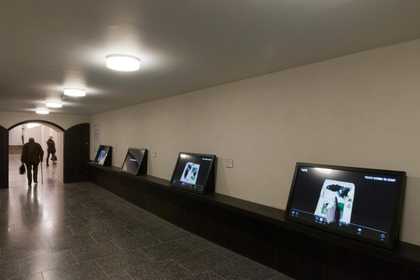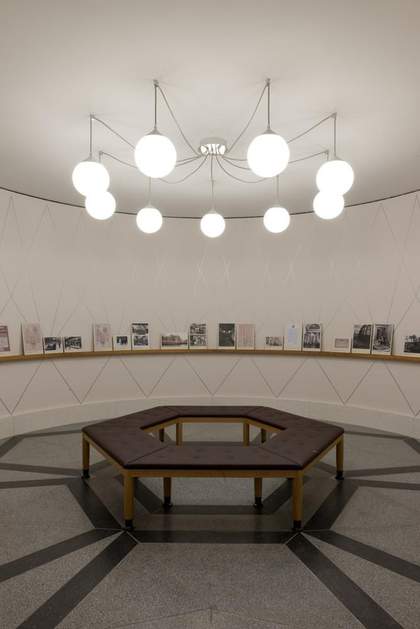Although the Archives and Access project has been very much about the transformation of original artefacts, sketches and documentation into the digital realm, we have not forgotten how visitors love to view archival material up close and personal. Indeed, as part of the wider Transforming Tate Britain project, £3 million of the overall £5 million grant by the Heritage Lottery Fund enabled Tate to create, for the first time, a suite of three galleries dedicated to treasures from the Archive (and from the Library and Public Records). Previously, archive displays had been hidden in nooks and crannies around the building, but now these displays are in permanent and more visible spaces.
Digital Corridor
The first of these galleries, the Digital Corridor, is the closest to the Hyman Kreitman Reading Rooms where Tate’s Library and Archive (and the gallery’s public records) are housed in a purpose-built research resource funded by a £2.2 million grant from the Hyman Kreitman Foundation in 2002.

© Tate photography
The Digital Corridor comprises four large screens where visitors can turn the pages of digitised bound volumes, such as sketchbooks, scrapbooks, notebooks, photograph and autograph albums, to view their contents at leisure. For instance, whenever, a work of art in Tate’s collection is referenced, visitors can access the image of the painting or sculpture to compare it next to the digitised image of the archival item on the page they are looking at. There are information panels, a means to manipulate each page on the screen, and even a magnifier to spot such delights as Barbara Hepworth working at her desk with a kitten by her feet. It is always a pleasure – whenever I pass by – to see younger members of families showing their parents how to use the touch screens and together explore the riches within.
Site Timeline gallery

© Tate photography
Just around the corner, towards Tate Britain’s new café and impressive spiral staircase, lies the Site Timeline gallery, housed in a circular space with extraordinary acoustics, where the architects have mined the Archive and the gallery’s own records for images that tell the story of the site, where Tate Britain now stands, from its days as an enormous penitentiary to the most recent refurbishment of the gallery. Unusual stories abound from prisoners being transported to Australia on ships via the nearby Thames to a message left by plasterers working on the original Tate gallery building in 1897 hoping that the Plasterers’ Association would still be flourishing and that whoever found the note ‘would drink their health in the other world’ (it is and they did on top of the glass dome in 1986!).
Archive gallery
On either side of this central space is the Archive gallery where the first exhibition, showcasing treasures from the Archive from the 19th century onwards, Reception, Rupture and Return: the Model and the Life Room, was displayed, 26 May 2014 – 19 April 2015.

© Tate photography
The planning of Reception, Rupture and Return: the Model and the Life Room
Six months in the planning the display, co-curated with Dr. Hester R. Westley, Research Fellow ‘Art School Educated’, took as its theme life drawing and the artist’s model. Hester and I spent a good proportion of time physically assessing items in multifarious archive collections. This is perhaps the most satisfying part of planning an exhibition – the in-depth research and analysis of items. Having drawn up a ‘long’ shortlist it was obvious that there was sufficient material to create a chronological display examining aspects of life drawing and the life room from the academic realism of the late 19th century and the swifter ‘arm’s length’ techniques seen at the Slade School of Art under Henry Tonks, through to English impressionism, in the guise of the New English Art Club, and avant-garde tendencies prior to the First World War to the slow diminution and influence of the life room from the 1950s until the recent resurgence of interest.
Rare archive material included in the display
Highlights included a rare sketchbook from Slade School days populated with sketches by friends of J. D Innes including two ‘sample’ sketches from life by Tonks, a very early (1914) colour photograph of Henry Scott Tuke painting on the beach in Falmouth and three incredibly rare sketchbooks by Henri Gaudier-Brzeska illustrating his transformation from realist to Vorticist artist before cruelly being cut down in the Great War.
In addition, we were able to show unknown holdings of the archive in terms of three archive collections relating to models. This is an example of where archive displays can reach areas that art exhibitions cannot necessarily reach. The three models were quite different: Marita Ross who modelled for the Royal Academy schools and Sir Gerald Kelly and then became a journalist writing about models’ lives; Eileen Mayo who was the muse for a number of female artists notably Dod Procter and Dame Laura Knight, as well as Duncan Grant, Mark Gertler and Jacob Epstein, but later became an artist in her right; and similarly a model turned artist, Isabel Rawsthorne who inspired artists as varied as Giacometti, Derain, Picasso and Francis Bacon to depict her.
And finally, the display was rounded off by audio recordings of some of Tuke’s models recorded in the 1960s housed in Tate Archive and extracts from artists remembering their time in the life room at various art schools from the British Library’s Artists’ Lives project to which Tate provides curatorial advice and support.
A successful display
All in all the display was a great success with more than 5,000 people per month visiting the Archive Gallery with many more visiting the other new spaces, made even more special by our fabulous new team of volunteer guides, ‘Archive Explorers’ who have been garnering excellent positive feedback from visitors. What was equally satisfying was the inclusion of so many examples of items digitised as part of the ‘Archives and Access’ part of the project with artefacts relating to Tuke, including his palette and photographs, Gotch and Stanhope Forbes from the Newlyn school, sketches by David Jones and William Rothenstein, the sketchbooks (already mentioned) of Henri Gaudier-Brzeska, and by Ithell Colquhoun, and individual sketches by Felicia Browne, Keith Vaughan, Aubrey Williams and Josef Herman.
A case of life drawing illuminating the digital.
